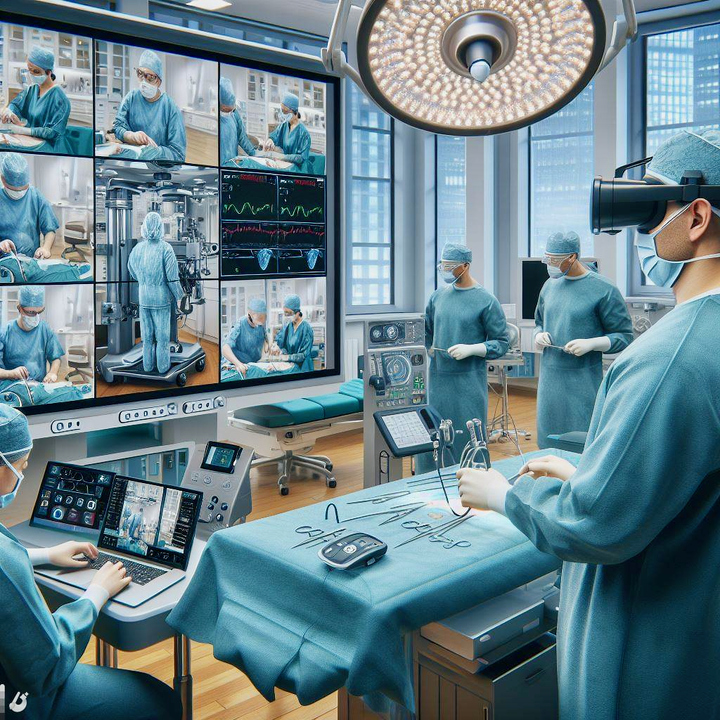The landscape of healthcare is undergoing a profound transformation, thanks to the advent of groundbreaking technologies. Among these, mSurgery technology stands out as a beacon of innovation, particularly in the realm of medical device manufacturing. This technology, particularly the mSurgery Communication Hub, is redefining the capabilities of surgical tools and devices, such as surgical robots and laparoscopic tools, by integrating advanced communication technologies. Here, we explore how this integration is revolutionizing healthcare.
Unveiling the Power of the mSurgery platform
Enhancing Surgical Training and Mentorship
One of the key benefits of mSurgery technology in medical devices is its ability to connect remote experts directly to the operating room (OR). This connection is not just a simple video call; it’s an immersive, high-definition, 3D experience that replicates being in the OR. For trainees and less experienced surgeons, this means they can receive real-time guidance and mentorship from experienced professionals during procedures.
Real-Time, High-Definition Learning
Imagine a scenario where a surgeon, performing a complex procedure, can have the guidance of a global expert in that specific surgery, all in real-time. The mSurgery Communication Hub makes this possible with its ultra-low latency of less than 0.5 seconds. This ensures that the advice and instructions from the mentor are received almost instantaneously, allowing for seamless integration into the surgical process.
Immersive 3D Visualization
The 3D image-sharing feature of mSurgery technology is a game-changer. Surgeons in training can observe procedures as if they were physically present in the OR, allowing for a more comprehensive understanding of the surgery. This immersive experience is crucial for complex surgeries where understanding spatial relationships and depth is essential.
Proctoring and Quality Assurance
mSurgery technology also opens new doors for proctoring. Experienced surgeons can oversee procedures remotely, ensuring that the highest standards of care are maintained. This is particularly vital in remote or underserved areas where access to expert surgeons might be limited.
Bridging the Gap in Remote Areas
Surgeons in remote locations can perform surgeries under the virtual guidance of experts, reducing the geographical barriers that often hinder the delivery of advanced medical care. This not only enhances the quality of surgical care in these areas but also helps in building the capacity of local healthcare professionals.
Facilitating Collaborative Surgery
The ability to share a real-time, high-definition, 3D view of the surgical field opens up possibilities for collaborative surgeries. Surgeons from different parts of the world can virtually join a procedure, contributing their expertise and skills to ensure the best possible outcomes for patients.
Global Expertise, Local Impact
By harnessing the power of global collaboration, mSurgery technology ensures that patients, irrespective of their location, can benefit from the expertise of the world’s best surgeons. This not only improves patient outcomes but also accelerates the adoption of innovative surgical techniques worldwide.
Opportunities and Considerations
The integration of mSurgery technology into medical device manufacturing is not just a leap forward for healthcare, but it also offers significant commercial benefits for Med Tech Product manufacturers. This innovative technology enhances the value of surgical devices such as robots and laparoscopic tools by making them more effective and versatile.
Enhanced Product Value and Appeal
By incorporating the mSurgery Communication Hub, manufacturers can elevate their products above the competition. The ability to offer real-time, high-definition, immersive 3D guidance transforms a standard surgical tool into a cutting-edge, collaborative platform. This added functionality can be a key differentiating factor in a market where technological superiority is a major selling point.
Streamlining Training and Onboarding
Traditionally, training surgeons on new medical devices has been a time-consuming and resource-intensive process, often involving face-to-face sessions and hands-on practice. With mSurgery technology, manufacturers can streamline this process significantly. Doctors can be trained easier and faster, without the need for physical presence, which means a quicker adoption rate of new technologies in the medical field.
Cost Savings and Operational Efficiencies
Remote training and proctoring capabilities lead to substantial cost savings for both manufacturers and healthcare providers. By reducing the need for travel, accommodation, and scheduling of in-person training sessions, a significant number of resources can be conserved. Moreover, the ability to provide high-quality training and support remotely means that manufacturers can scale their operations more efficiently, reaching a global market without the associated logistical burdens.
Enhancing Customer Satisfaction and Loyalty
When medical professionals can easily and effectively be trained on the use of a device, their satisfaction with the product increases. This ease of use and the ability to access expert guidance remotely not only improves the user experience but also builds trust and loyalty toward the manufacturer. In the long run, this can translate into sustained customer relationships and a stronger brand reputation in the healthcare industry.
Driving Innovation and Market Leadership
Embracing mSurgery technology positions Med Tech Product manufacturers as leaders in innovation. By proactively integrating such advanced communication technologies, manufacturers are not just selling a product; they are offering a comprehensive solution that addresses the evolving needs of modern healthcare. This approach can set a new standard in the industry, propelling manufacturers to the forefront of medical technology.
Conclusions
In summary, the adoption of mSurgery technology offers a symbiotic advantage. It revolutionizes surgical practices and training, while also providing tangible commercial benefits to Med Tech Product manufacturers. It paves the way for easier, faster, and more cost-effective training, and ensures the delivery of high-quality medical devices that are at the forefront of technological innovation. As we move forward, the integration of such technologies will undoubtedly become a cornerstone in the continual advancement of medical device manufacturing.
